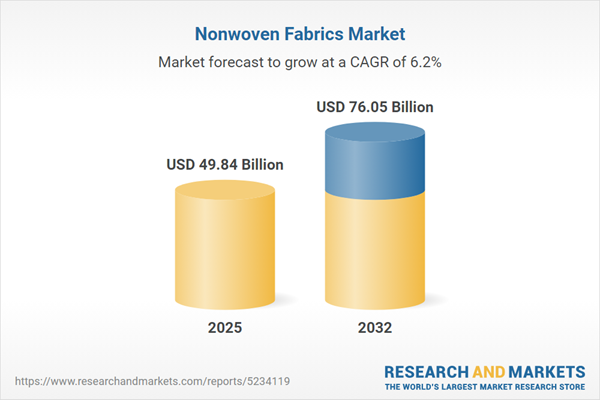Speak directly to the analyst to clarify any post sales queries you may have.
The nonwoven fabrics market is undergoing significant transformation, driven by advances in material technology and evolving customer requirements across numerous industries. As innovation reshapes value chains and sustainability becomes a priority, nonwoven fabrics are central to delivering new solutions for diverse applications.
Market Snapshot: Nonwoven Fabrics Market Growth
The nonwoven fabrics market grew from USD 46.97 billion in 2024 to USD 49.84 billion in 2025. It is expected to continue expanding at a compound annual growth rate (CAGR) of 6.20%, reaching USD 76.05 billion by 2032. Heightened demand for performance materials in sectors such as medical, hygiene, filtration, automotive, and construction supports this trajectory, alongside an ongoing pivot to sustainable production methods.
Scope & Segmentation: Evolving Demand and Solutions
- Type: Airlaid, Drylaid, Meltblown, Spunbond, Wetlaid
- Material Type: Natural Fiber, Regenerated Fiber, Synthetic Polymer
- Category: Disposable, Non-Disposable
- Layer: Multilayer, Single-layer
- Application: Apparel, Filtration, Hygiene Products, Personal Care
- End Use Industry: Automotive, Construction & Building, Furniture, Healthcare, Textiles
- Distribution Channel: Offline Sales, Online Sales
- Region: Americas (United States, Canada, Mexico, Brazil, Argentina, Chile, Colombia, Peru), Europe, Middle East & Africa (United Kingdom, Germany, France, Russia, Italy, Spain, Netherlands, Sweden, Poland, Switzerland, United Arab Emirates, Saudi Arabia, Qatar, Turkey, Israel, South Africa, Nigeria, Egypt, Kenya), Asia-Pacific (China, India, Japan, Australia, South Korea, Indonesia, Thailand, Malaysia, Singapore, Taiwan)
- Companies: Ahlstrom-Munksjö Oyj, Asahi Kasei Corporation, Autotech Nonwovens Pvt. Ltd., Avgol Ltd., A Berkshire Hathaway Company, Bayteks Teknik Tekstil San. ve Tic. A.Ş, Berry Global Inc. by Amcor PLC, Cygnus Group, DuPont de Nemours, Inc., Exxon Mobil Corporation, Fibertex Nonwovens A/S, Fiberwebindia Ltd, Fitesa S.A., Freudenberg SE, Hollingsworth & Vose Company, Hydroweb GmbH, Kimberly-Clark Corporation, Kt Exports (India) Pvt. Ltd., Lydall, Inc., Mitsui Chemicals, Inc., Mogul Co., Ltd., PFNonwovens Group, Radici Partecipazioni SpA, Sandler Nonwoven Corporation, Sunshine Nonwoven Fabric Co.,ltd, Suominen Corporation, Toray Industries, Inc., TWE GmbH & Co. KG
Key Takeaways: Strategic Insights for Decision-Makers
- Rapid innovation is catalyzing the development of nonwoven fabrics with finer fibers and enhanced properties, expanding applicability in filtration, healthcare, and high-performance industrial uses.
- Sustainability initiatives are reshaping material sourcing, with increased investment in bio-based and recycled fibers supporting circular economy practices across the value chain.
- Manufacturers are adopting advanced production techniques, such as electrospinning, meltblown, and airlaid processes, to deliver tailored solutions for evolving end-use demands.
- Digitalization and real-time analytics are empowering producers to optimize resource use, achieve better product quality, and improve supply chain agility.
- Segmentation shifts, including greater customization for consumer, medical, and automotive markets, are driving demand for multilayer constructions and composites.
- Geographical developments reflect the impact of region-specific regulations, infrastructure expansion, and differentiated adoption rates—particularly in the Americas, Asia-Pacific, and EMEA regions.
Tariff Impact: U.S. Trade and Capacity Shifts
The 2025 U.S. tariff adjustments have led firms to reevaluate sourcing, prioritize nearshoring, and invest in local manufacturing. These changes are strengthening supply chain resilience while stimulating domestic capacity for medical and filtration nonwovens.
Methodology & Data Sources
This report utilizes a hybrid approach, combining primary interviews with industry experts and executives with comprehensive secondary literature reviews. Both top-down and bottom-up methods support rigorous market validation and trend analysis throughout the nonwoven fabrics value chain.
Why This Report Matters
- Provides actionable insights for supply chain optimization, technology adoption, and market positioning in the nonwoven fabrics industry.
- Supports strategic planning with timely analysis of regulatory, trade, and sustainability factors influencing global and regional markets.
- Enables executive decision-makers to identify partnership, investment, and product innovation opportunities for long-term growth.
Conclusion
Innovation, sustainability, and evolving global trade are converging to reshape the nonwoven fabrics landscape. Industry leaders equipped with the latest insights can navigate shifting market demands and build competitive advantage.
Additional Product Information:
- Purchase of this report includes 1 year online access with quarterly updates.
- This report can be updated on request. Please contact our Customer Experience team using the Ask a Question widget on our website.
Table of Contents
3. Executive Summary
4. Market Overview
7. Cumulative Impact of Artificial Intelligence 2025
List of Figures
Samples

LOADING...
Companies Mentioned
The key companies profiled in this Nonwoven Fabrics market report include:- Ahlstrom-Munksjö Oyj
- Asahi Kasei Corporation
- Autotech Nonwovens Pvt. Ltd.
- Avgol Ltd.
- A Berkshire Hathaway Company
- Bayteks Teknik Tekstil San. ve Tic. A.Ş
- Berry Global Inc. by Amcor PLC
- Cygnus Group
- DuPont de Nemours, Inc.
- ExxonMobil Corporation
- Fibertex Nonwovens A/S
- Fiberwebindia Ltd
- Fitesa S.A.
- Freudenberg SE
- Hollingsworth & Vose Company
- Hydroweb GmbH
- Kimberly-Clark Corporation
- Kt Exports (India) Pvt. Ltd.
- Lydall, Inc.
- Mitsui Chemicals, Inc.
- Mogul Co., Ltd.
- PFNonwovens Group
- Radici Partecipazioni SpA
- Sandler Nonwoven Corporation
- Sunshine Nonwoven Fabric Co.,ltd
- Suominen Corporation
- Toray Industries, Inc.
- TWE GmbH & Co. KG
Table Information
| Report Attribute | Details |
|---|---|
| No. of Pages | 195 |
| Published | October 2025 |
| Forecast Period | 2025 - 2032 |
| Estimated Market Value ( USD | $ 49.84 Billion |
| Forecasted Market Value ( USD | $ 76.05 Billion |
| Compound Annual Growth Rate | 6.2% |
| Regions Covered | Global |
| No. of Companies Mentioned | 29 |









